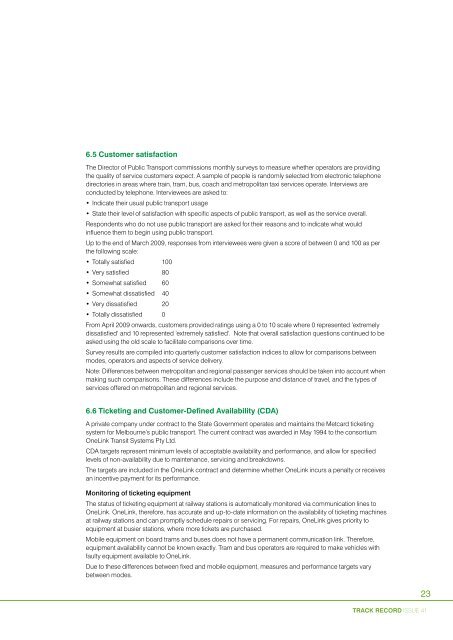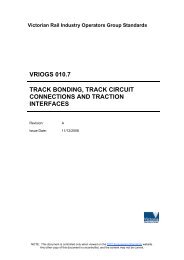Track Record 41, October to December 2009 - Public Transport ...
Track Record 41, October to December 2009 - Public Transport ...
Track Record 41, October to December 2009 - Public Transport ...
You also want an ePaper? Increase the reach of your titles
YUMPU automatically turns print PDFs into web optimized ePapers that Google loves.
6.5 Cus<strong>to</strong>mer satisfaction<br />
The Direc<strong>to</strong>r of <strong>Public</strong> <strong>Transport</strong> commissions monthly surveys <strong>to</strong> measure whether opera<strong>to</strong>rs are providing<br />
the quality of service cus<strong>to</strong>mers expect. A sample of people is randomly selected from electronic telephone<br />
direc<strong>to</strong>ries in areas where train, tram, bus, coach and metropolitan taxi services operate. Interviews are<br />
conducted by telephone. Interviewees are asked <strong>to</strong>:<br />
• Indicate their usual public transport usage<br />
• State their level of satisfaction with specific aspects of public transport, as well as the service overall.<br />
Respondents who do not use public transport are asked for their reasons and <strong>to</strong> indicate what would<br />
influence them <strong>to</strong> begin using public transport.<br />
Up <strong>to</strong> the end of March <strong>2009</strong>, responses from interviewees were given a score of between 0 and 100 as per<br />
the following scale:<br />
• Totally satisfied 100<br />
• Very satisfied 80<br />
• Somewhat satisfied 60<br />
• Somewhat dissatisfied 40<br />
• Very dissatisfied 20<br />
• Totally dissatisfied 0<br />
From April <strong>2009</strong> onwards, cus<strong>to</strong>mers provided ratings using a 0 <strong>to</strong> 10 scale where 0 represented ’extremely<br />
dissatisfied‘ and 10 represented ’extremely satisfied‘. Note that overall satisfaction questions continued <strong>to</strong> be<br />
asked using the old scale <strong>to</strong> facilitate comparisons over time.<br />
Survey results are compiled in<strong>to</strong> quarterly cus<strong>to</strong>mer satisfaction indices <strong>to</strong> allow for comparisons between<br />
modes, opera<strong>to</strong>rs and aspects of service delivery.<br />
Note: Differences between metropolitan and regional passenger services should be taken in<strong>to</strong> account when<br />
making such comparisons. These differences include the purpose and distance of travel, and the types of<br />
services offered on metropolitan and regional services.<br />
6.6 Ticketing and Cus<strong>to</strong>mer-Defined Availability (CDA)<br />
A private company under contract <strong>to</strong> the State Government operates and maintains the Metcard ticketing<br />
system for Melbourne’s public transport. The current contract was awarded in May 1994 <strong>to</strong> the consortium<br />
OneLink Transit Systems Pty Ltd.<br />
CDA targets represent minimum levels of acceptable availability and performance, and allow for specified<br />
levels of non-availability due <strong>to</strong> maintenance, servicing and breakdowns.<br />
The targets are included in the OneLink contract and determine whether OneLink incurs a penalty or receives<br />
an incentive payment for its performance.<br />
Moni<strong>to</strong>ring of ticketing equipment<br />
The status of ticketing equipment at railway stations is au<strong>to</strong>matically moni<strong>to</strong>red via communication lines <strong>to</strong><br />
OneLink. OneLink, therefore, has accurate and up-<strong>to</strong>-date information on the availability of ticketing machines<br />
at railway stations and can promptly schedule repairs or servicing. For repairs, OneLink gives priority <strong>to</strong><br />
equipment at busier stations, where more tickets are purchased.<br />
Mobile equipment on board trams and buses does not have a permanent communication link. Therefore,<br />
equipment availability cannot be known exactly. Tram and bus opera<strong>to</strong>rs are required <strong>to</strong> make vehicles with<br />
faulty equipment available <strong>to</strong> OneLink.<br />
Due <strong>to</strong> these differences between fixed and mobile equipment, measures and performance targets vary<br />
between modes.<br />
23<br />
<strong>Track</strong> <strong>Record</strong> ISSuE <strong>41</strong>

















